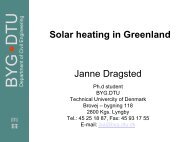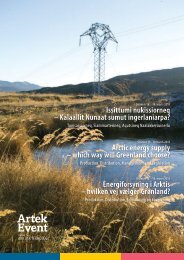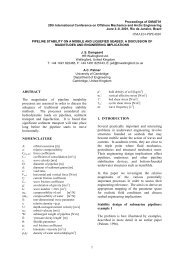Cantilever-like micromechanical sensors - Artek
Cantilever-like micromechanical sensors - Artek
Cantilever-like micromechanical sensors - Artek
Create successful ePaper yourself
Turn your PDF publications into a flip-book with our unique Google optimized e-Paper software.
Rep. Prog. Phys. 74 (2011) 036101 A Boisen et al<br />
Table 1. Summary of experimental findings with respect to the origin of surface stress.<br />
System<br />
Year Reference Argument studied<br />
2000 [19] Electrostatic, steric and hydrophobic DNA in saline sodium citrate hybridization<br />
buffer<br />
2001 [70] Interplay between configurational DNA in sodium phosphate buffer<br />
entropy and inter-molecular energetics<br />
2002 [71] Electrostatic and steric hindrance effects DNA in triethyl ammonium acetate buffer<br />
2005 [80] Electrostatic (and entropic, hydrophobic, DNA in saline sodium phosphate buffer<br />
hydration and solvation surface forces)<br />
2006 [72] Electrostatics, ionic hydrogen bonds. Thiolated alkanechains in sodium phosphate<br />
The effect of counter ions from aqueous solution buffer<br />
2008 [79] Hydration forces in between ss-DNA or ds-DNA DNA in saline sodium phosphate buffer<br />
2010 [74] Intermolecular electrostatics, Lennard-Jones interactions, Thiolated alkanechains deposited<br />
the effect of adsorption-induced changes in the electronic from deposited from the gas phase<br />
density of the metal film combined with the associated<br />
electronic charge transfer from the gold to the thiol bond<br />
It was seen that e-beam deposition results in compressive stress<br />
whereas resistive heating deposition results in tensile stress.<br />
Furthermore, the effect of grounding the gold-coated cantilever<br />
during immobilization was investigated. The surface stress of<br />
the cantilever coated with gold using resistive heating changed<br />
from tensile to compressive when the cantilever was grounded.<br />
The topography of the two gold films were similar and the<br />
authors conclude that the critical feature must be the charge<br />
state of the gold film that makes the DNA strands arrange<br />
themselves differently depending on the interaction of the<br />
phosphate back-bone and the gold layer.<br />
2.2.3. Surface stress measurements—hydration forces. In<br />
2007, an idea proposed by Hagan et al in 2002 [67] was<br />
tested experimentally by the group of Tamayo [79]. The<br />
theoretical proposal suggests that hydration forces have a<br />
large impact/significance on the generated surface stress.<br />
The experiments show that both ss-DNA immobilization and<br />
DNA hybridization can be measured with high accuracy (fM<br />
concentrations) by simply observing the cantilever deflection<br />
as the relative humidity of the environment is alternated<br />
between 0% and 100%. The behaviour of a ss-DNA layer and a<br />
ds-DNA layer as a function of humidity is drastically different.<br />
Therefore the effect can be used to detect hybridization.<br />
2.2.4. Surface stress measurements—conclusions. In<br />
conclusion, many experimental conditions influence the<br />
surface stress generation and great care has to be taken in design<br />
and interpretation of experiments. A summary of experimental<br />
findings with respect to the origin of surface stress is given in<br />
table 1. Issues such as gold coating of the cantilever, which<br />
at first seems very straightforward, have been seen to have<br />
large influence on the signal generation. More fundamental<br />
investigations are needed in order to fully understand the<br />
origin of surface stress. By understanding and controlling<br />
the many factors contributing to the generation of surface<br />
stress it will be possible to find ways of enhancing sensitivity<br />
and reliability of the signal. Naturally, reference cantilevers<br />
that can eliminate responses due to external factures such as<br />
temperature variations or buffer changes should be utilized.<br />
9<br />
2.3. Detection of effects related to bulk stress changes<br />
The considerations on surface stress changes only apply when<br />
the thickness of the thin film on the top of the cantilever is much<br />
smaller than the thickness of the cantilever itself. In several<br />
applications stress is generated in the bulk of the cantilever<br />
material(s) whereby the signal interpretations as well as the<br />
general applications are different. Bulk stress changes can,<br />
for example, be applied in temperature sensing utilizing bimaterial<br />
cantilevers. Using strings, volume changes in a single<br />
material are easily detectable.<br />
2.3.1. Bi-material cantilever. Bi-material cantilevers consist<br />
of two material layers with different expansion coefficients α1<br />
and α2. If such a bimorph cantilever is exposed to a changing<br />
influence parameter (i.e. temperature or humidity), named X,<br />
and X0 is the initial parameter value, the cantilever bends. The<br />
tip deflection of a bi-material cantilever is given by [81–83]<br />
x(X)<br />
⎡<br />
⎤<br />
= 3L2<br />
h 2 2<br />
⎢<br />
(h1 ⎢<br />
+ h2)<br />
⎢ <br />
⎣<br />
3 1+ h1<br />
<br />
2<br />
h1 E1<br />
+ 1+<br />
h2<br />
h2 E2<br />
<br />
h1<br />
h2<br />
+ h2 E2<br />
h1 E1<br />
⎥<br />
⎥<br />
⎦<br />
×(α1 − α2)(X − X0), (2.23)<br />
where h1 and h2 are the thicknesses and E1 and E2 the<br />
corresponding Young’s moduli of the two material layers. The<br />
bending response of a bimorph cantilever can be optimized by<br />
choosing the right thickness corresponding to equation (2.23).<br />
The two materials need to have different expansion coefficients<br />
with respect to the parameter/analyte to be detected and should<br />
be chosen carefully in order to optimize sensitivity. The<br />
best known application of bi-material cantilevers is as thermal<br />
<strong>sensors</strong> where two materials with different thermal expansion<br />
coefficients are used [81, 84, 85]. Bi-material cantilevers can<br />
also be used as chemical [82, 86] and humidity <strong>sensors</strong> [3, 87].<br />
If the sensitive layer is significantly thinner than the structural<br />
layer, the bending behaviour can be approximated by Stoney’s<br />
equation (2.21).





